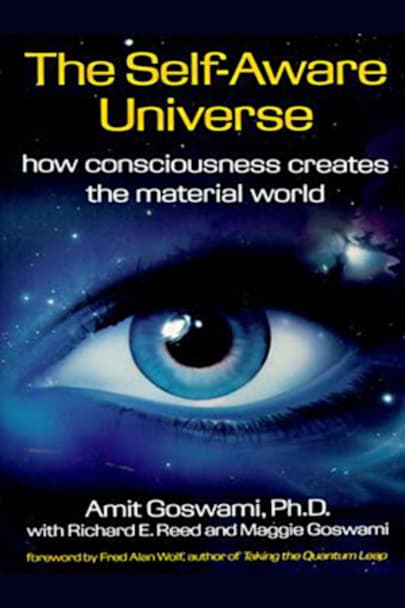In this stimulating and timely book, Amit Goswami, PhD, shatters the widely popular belief held by Western science that matter is the primary “stuff” of creation and proposes instead that consciousness is the true foundation of all we know and perceive. His explanation of quantum physics for lay readers, called “a model of clarity” by Kirkus Reviews, sets the stage for a voyage of discovery … discovery through the common ground of science and religion, the entwined nature of mind and body, and our interconnectedness with all of creation.
more



Not since Dr. Fritjof Capra’s “The Tao of Physics” has a book by a physicist had such impact on my worldview as Dr. Amit Goswami’s book, “The Self-Aware Universe: How Consciousness Creates the Material World.”
Dr. Goswami begins by describing the bizarre realities of the quantum world: a quantum object, such as an electron, can be at more than one place at the same time—it doesn’t manifest in space-time reality until we observe it. When a quantum object is observed, it can mysteriously jump from one spot in space to another, and also affect a correlated twin object, no matter how far apart they are. So where does a quantum object exist when it “jumps” from one spot in space to another? Dr. Goswami says it exists in the transcendent dimension of reality.
A transcendent dimension!
I’m the first to admit that a purely material, physical world is ultimately a dead world, devoid of meaning or significance. I don’t want to live in such a world. The material realist worldview, which presumes only physical matter is real, means that I have no soul, and that my consciousness dies with my body. How depressing.
Dr. Goswami posits instead a worldview of monistic idealism, where consciousness is the basic element of reality, and matter is secondary. The “monistic” part of this worldview means that reality is one unitary organic whole with no independent parts.
That means my soul is like a single drop of water in an ocean. The idea is a little unsettling, because it deprives me of my sense of being an individual; yet it also gives me what I secretly yearn for anyway—the certainty that I am connected with and one with the divine life-force and intelligence comprising the entire universe.
Individual separateness is an illusion, says Dr. Goswami. He links physics to psychology when he brings up Carl Jung and says that the Swiss psychiatrist discovered empirically that there is a transpersonal collective aspect of our unconscious operating outside space-time (Jungian synchronicity). This collective unconscious is the same one that allows out-of-body experience to occur. People do have mystical experiences that fail to correspond to consensus reality.
Thus, without some form of realism and consensus, Dr. Goswami admits, science is impossible. He explains our brain-minds function as part of a unitive consciousness, and that’s how we arrive at consensus reality. How does unitive consciousness split itself into a subject that experiences (the “I” of the human self) and objects that are experienced? The individual self-experience, or ego, he says, arises in the mirror of memory. The highest levels of consciousness are ego-less.
Becoming aware of our common bedrock of consciousness may be humanity’s salvation—saving us from self-destruction via nuclear annihilation and the wrecking of our natural environment. Communication technology (the Internet) is helping to gather humanity together. At higher levels of consciousness, rigid thoughts and beliefs fall away, replaced by a more enlightened worldview: “I am not separate from my neighbor.”
This is an uplifting book. Although it’s daunting to slog through the science, I recommend it. Dr. Goswami has made quantum science more accessible to the lay person through his stories, metaphors and gentle humor.